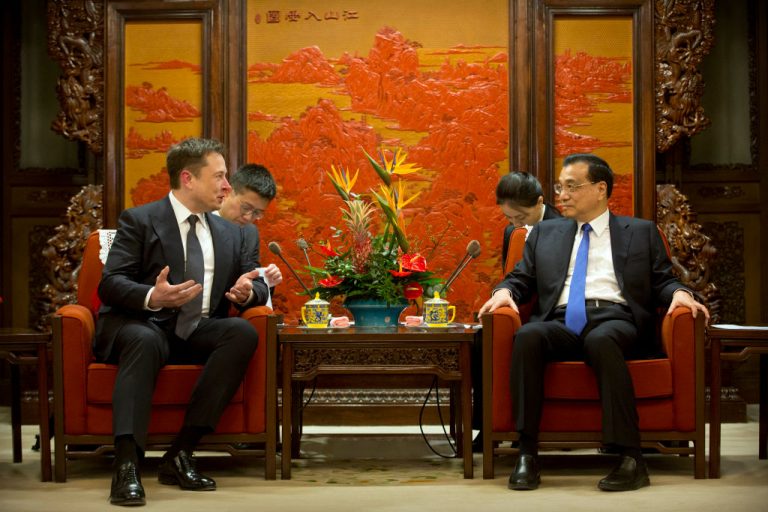Tesla chief Elon Musk praised China’s business practices for the second time in as many weeks, doubling down on his commitment to invest in and offshore research and development spending from the United States to the communist country that hosts a factory that now comprises almost half of the company’s Model 3 and Model Y production.
In a pre-recorded question and answer clip given by Musk to the World Internet Conference on Sept. 25, hosted by the Chinese Communist Party’s (CCP) internet regulator, the Cyberspace Administration of China, Musk made conciliatory comments praising the Chinese government’s business policies.
“My frank observation is that China spends a lot of resources and efforts applying the latest digital technologies in different industries, including the automobile industry, making China a global leader in digitalization.”
“Tesla will continue to expand our investment and R&D efforts in China,” he said.
Just nine days earlier, Musk made similar comments in an analogously prepared question and answer video for the World New Energy Vehicle Congress, hosted by seven different ministries of the Chinese government, where he said, “I have a great deal of respect for the many Chinese automakers for driving these (EV) technologies,” adding that his Chinese rivals were “most competitive in the world.”
Success
You are now signed up for our newsletter
Success
Check your email to complete sign up
In July, Breitbart reported that both Tesla and Musk’s verified accounts on Weibo, the Chinese version of Twitter, donned themselves in customized red graphics celebrating the 100th Anniversary of the CCP’s founding.
On June 30, CCP mouthpiece Xinhua News Agency published a propaganda tweet in celebration of the Party’s Anniversary, praising the regime for “building a moderately prosperous society in all respects.” Xinhua also claimed the Party had “brought about a historic resolution to the problem of absolute poverty in China,” and boasted a stated goal of “building China into a great modern socialist country in all respects.”
Musk took it upon himself to reply to Xinhua in an ingratiating fashion, “The economic prosperity that China has achieved is truly amazing, especially in infrastructure! I encourage people to visit and see for themselves,” he said.
The tweet was echoed by Musk’s Weibo account, complete with a Chinese-language translation.
In 2019, Tesla opened a massive “Gigafactory” on the outskirts of Shanghai, breaking from a growing trend of maintaining, enhancing, and developing U.S.-based production under the Trump administration’s America First initiative.
In Tesla’s 2018 vehicle production and deliveries press release, the company blamed Donald Trump’s trade war with the CCP for a 40 percent tariff imposed on Tesla’s imports by Beijing. The presser also said Tesla was at a financial disadvantage arising from a “lack [of] access to cash incentives available to locally produced electric vehicles in China that are typically around 15% of MSRP or more.”
“Taking ocean transport costs and import tariffs into account, Tesla is now operating at a 55% to 60% cost disadvantage compared to the exact same car locally produced in China. This makes for a challenging competitive environment, given that China is by far the largest market for electric vehicles,” said the release.
“To address this issue, we are accelerating construction of our Shanghai factory, which we expect to be a capital efficient and rapid buildout, using many lessons learned from the Model 3 ramp in North America.”
On Sept. 25, Business Insider reported based on data provided by Chinese sources who “requested anonymity, as they were not allowed to speak to the media,” that the Shanghai Gigafactory had pumped out 300,000 Model 3 sedans and Model Y SUVs in the first nine months of 2021.
The article said a Chinese official “in the area where Tesla’s factory is located” said the Gigafactory would produce 450,000 vehicles this year, more than 66,000 of which are to be exported to Germany, Japan, and the United Kingdom.
In August, enthusiast website Teslarati said, based on figures provided by the Chinese Passenger Car Association, that the Shanghai Gigafactory exported 24,347 vehicles in July alone, comprising 73 percent of the month’s production.
In its Q2 2021 investor relations deck, Tesla said that “due to strong U.S. demand and global average cost optimization, we have completed the transition of Gigafactory Shanghai as the primary vehicle export hub.
The deck also noted the Shanghai facility as having an annual capacity of “>450,000” vehicles per year, which is almost the same as the Model 3 and Model Y facility in California listed at 500,000.
















